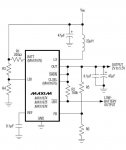yeah its that complicated cos its a schematic for a demo board. you could cut away most of the stuff at the bottom.
phenol-
the higher the reference voltage, the more power will have to be wasted in the shunt to measure the current. so if you have a 1.25v ref, you will be wasting 30% of the total power in the shunt if you are running a 3V diode. that being said, if you don't care about efficiency and you are using a boost configuration, it doesn't matter.
btw with a .235V ref as with the ncp3065, only 7% of total power is wasted in the shunt when running a 3V diode.
and also, the 3065 is avaliable in your normal through-hole package
phenol-
the higher the reference voltage, the more power will have to be wasted in the shunt to measure the current. so if you have a 1.25v ref, you will be wasting 30% of the total power in the shunt if you are running a 3V diode. that being said, if you don't care about efficiency and you are using a boost configuration, it doesn't matter.
btw with a .235V ref as with the ncp3065, only 7% of total power is wasted in the shunt when running a 3V diode.
and also, the 3065 is avaliable in your normal through-hole package





